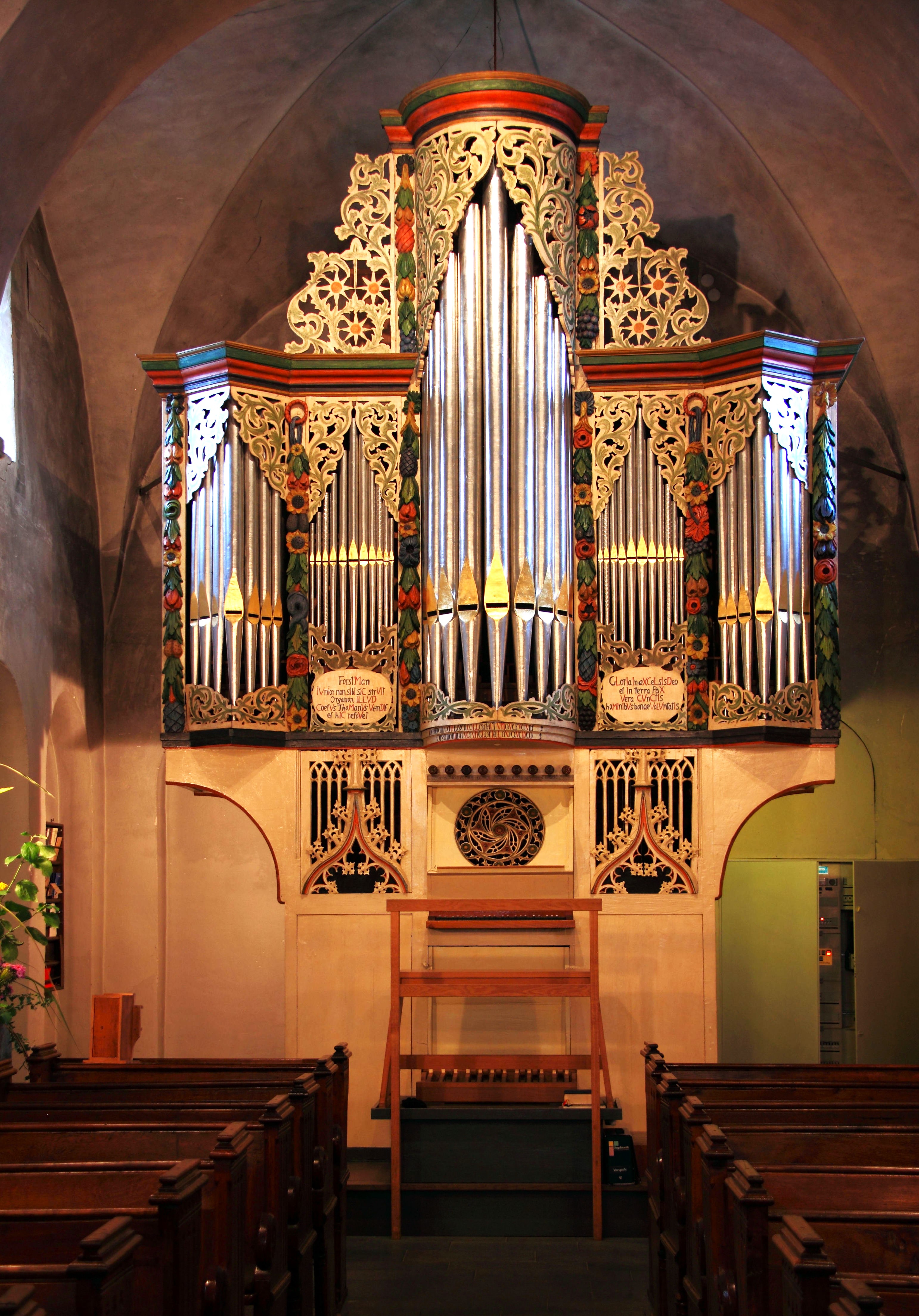Ostönnen, Sankt Andreas
| Builder | Anonymous |
|---|---|
| Year | ca. 1431 |
| Period/Style | Gothic |
| Stops | 8 |
| Keyboards | 1+P |
| Keyaction | tracker/mechanical |
| Tuning | 1/4 Comma Meantone at 482 Hz |
The Gothic-Baroque organ of St. Andreas in Ostönnen is a significant technical, artistic, and cultural monument. It is among the oldest playable organs in the world, comparable to instruments in Sion, Kiedrich, Rysum, and Bologna, and is likely the oldest among them. The organ currently has eight registers with 576 pipes, more than half of which (326) date back to before 1500. The Baroque exterior was crafted by Johann Patroclus Möller, who reassembled and modified the organ in Ostönnen from 1721 to 1722.
The origins of the instrument remain unclear despite extensive research; neither the original builder nor the intended location is known. The first documented repair occurred in 1586 by a master named Bartholdus. At that time, the organ was located in the Alt St. Thomae Church in Soest, and Bartholdus added two new registers: a Gedackt made from old pipes and a newly built trumpet. The wood of the wind chests dates between 1425 and 1431, with some parts dating back to 1410. The substantial Gothic wind chest consists of three thick oak boards and features complex drilling for the pipes, highlighting its ancient construction techniques.
In 1720, the then 21-year-old Johann Patroclus Möller was commissioned to build a new organ for the Soester Thomaekirche but was required to take the "old ruinous" instrument as part payment. He relocated this organ to St. Andreas Church in Ostönnen in 1721-1722, placing it on a now-lost gallery. Möller added the missing notes Es, Fis, and Gis and redesigned the case in Baroque style, retaining the original prospect pipes and replacing only irreparable ones. The organ underwent various repairs and modifications over the centuries, including significant changes in 1820, 1874, and a major restoration by Paul Ott in 1963.
A comprehensive restoration by Rowan West began in 2000, aiming to restore the organ to its 1722 state based on recommendations from Gothic pipe expert Koos van de Linde. The restoration prioritized the organ's sound as a historical monument over its technical state. All pipes dating from around 1500 were preserved and reused, while pipes made by Paul Ott were replaced. The prospect pipes were covered with tin foil and gold leaf according to historical findings. The organ was recognized as the Monument of the Month in Westfalen-Lippe in August 2003 and was rededicated in a ceremony on November 8, 2003.
The origins of the instrument remain unclear despite extensive research; neither the original builder nor the intended location is known. The first documented repair occurred in 1586 by a master named Bartholdus. At that time, the organ was located in the Alt St. Thomae Church in Soest, and Bartholdus added two new registers: a Gedackt made from old pipes and a newly built trumpet. The wood of the wind chests dates between 1425 and 1431, with some parts dating back to 1410. The substantial Gothic wind chest consists of three thick oak boards and features complex drilling for the pipes, highlighting its ancient construction techniques.
In 1720, the then 21-year-old Johann Patroclus Möller was commissioned to build a new organ for the Soester Thomaekirche but was required to take the "old ruinous" instrument as part payment. He relocated this organ to St. Andreas Church in Ostönnen in 1721-1722, placing it on a now-lost gallery. Möller added the missing notes Es, Fis, and Gis and redesigned the case in Baroque style, retaining the original prospect pipes and replacing only irreparable ones. The organ underwent various repairs and modifications over the centuries, including significant changes in 1820, 1874, and a major restoration by Paul Ott in 1963.
A comprehensive restoration by Rowan West began in 2000, aiming to restore the organ to its 1722 state based on recommendations from Gothic pipe expert Koos van de Linde. The restoration prioritized the organ's sound as a historical monument over its technical state. All pipes dating from around 1500 were preserved and reused, while pipes made by Paul Ott were replaced. The prospect pipes were covered with tin foil and gold leaf according to historical findings. The organ was recognized as the Monument of the Month in Westfalen-Lippe in August 2003 and was rededicated in a ceremony on November 8, 2003.
| Manual | Pedal (always attached) |
|---|---|
| Praestant 8′ | |
| Gedackt 8′ | |
| Octav 4′ | |
| Quinta 3′ | |
| Superoctav 2′ | |
| Sexquialtera II | |
| Mixtur IV | |
| Trompete B/D 8′ |
https://de.wikipedia.org/wiki/Orgel_von_St._Andreas_(Ost%C3%B6nnen)
https://www.orgel-owl.de/ind_lorg.htm
https://www.orgel-owl.de/ind_lorg.htm
 Pipe Organ Map
Pipe Organ Map